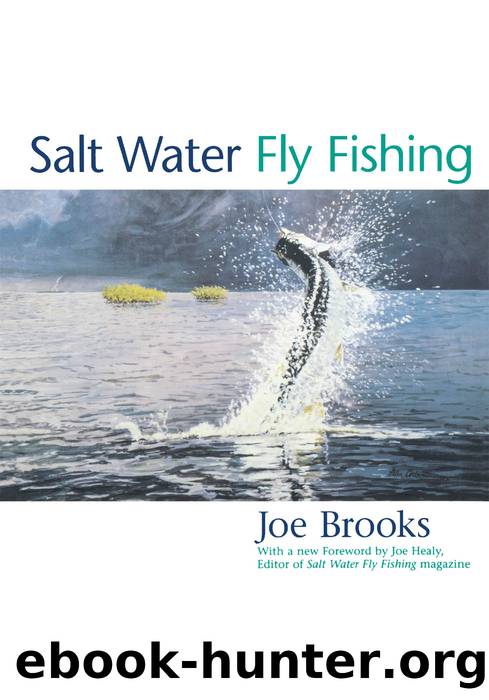Salt Water Fly Fishing by Joe Brooks

Author:Joe Brooks
Language: eng
Format: epub
Publisher: Derrydale Press
Published: 2000-01-15T00:00:00+00:00
The author with the world-record (fly-rod) striped bass taken at Coos Bay, Oregon. The big striper socked a white popping bug and battled forty minutes before being boated. Photo by Coos Bay (Oregon) Times.
Fishing the surf at Bermuda for the scrappy and dashing gaff-topsail pompano. Along any of Bermudaâs beautiful pink beaches fine sport can be had with the surf-racing pompano by merely wading in and casting. The clearness of the water allows you to spot your fish and make your cast directly to him. Bermuda News Bureau, Photo bu Higgs.
While as a general rule bonefish like a slow retrieveâjust fast enough to keep the hook from fouling on the bottomâthere are notable exceptions to the rule. Sometimes schools of bonefish are seen sweeping across the flats. Thy make such a commotion in the water that they can be spotted from a distance. Perhaps they have finished feeding and are heading for a resting place or perhaps a fast-dropping tide is making them scurry to safety. Certainly they are traveling at a much faster pace than usual. Under such conditions, a quick toss ahead of them and a very fast retrieve will frequently take a fish. On the other hand, I have also seen bonefish from such a school follow, take a fly, and then eject it again. A fish in one school to which I cast did this three times, finally leaving the fly altogether, while I stood there open mouthed and desperate. The same thing happened again later, so I struck the next one the minute he took. The fly, as I had expected, pulled right out of his mouth and I let it stay still for a moment before starting the retrieve. He repeated and took it in his mouth, only to eject it once more. I kept the fly coming and suddenly, from only 15 feet away, he socked it so hard he almost knocked the rod out of my hand!
But fish from these fast-traveling schools usually hit savagely, detaching themselves from the school and socking the fly while still moving at the speed of the other fish. The fish sees something good to eat and wants to get it in a hurry and rejoin his onrushing mates. The fast retrieve is absolutely necessary if you want to catch fish from these schools. They are scurrying along at a rapid pace and if you cast your fly and allow it to just float in the water, or do not retrieve it at a speed faster than the fish are moving, they will think it is just a bit of grass or other matter floating in the water. They need to see it moving faster than they are, to realize that it is something good to eat.
When a bonefish is hooked, he usually starts for deep water. He doesnât leap or jump as so many fish do, but travels at express-train speed, usually in a straight line. His first run may be 200 or 300 feet. It may be 400.
Download
This site does not store any files on its server. We only index and link to content provided by other sites. Please contact the content providers to delete copyright contents if any and email us, we'll remove relevant links or contents immediately.
The Lonely City by Olivia Laing(4766)
Animal Frequency by Melissa Alvarez(4422)
All Creatures Great and Small by James Herriot(4266)
Walking by Henry David Thoreau(3919)
Exit West by Mohsin Hamid(3789)
Origin Story: A Big History of Everything by David Christian(3665)
COSMOS by Carl Sagan(3583)
How to Read Water: Clues and Patterns from Puddles to the Sea (Natural Navigation) by Tristan Gooley(3429)
Hedgerow by John Wright(3313)
How to Read Nature by Tristan Gooley(3289)
The Inner Life of Animals by Peter Wohlleben(3282)
How to Do Nothing by Jenny Odell(3263)
Project Animal Farm: An Accidental Journey into the Secret World of Farming and the Truth About Our Food by Sonia Faruqi(3188)
Origin Story by David Christian(3168)
Water by Ian Miller(3150)
A Forest Journey by John Perlin(3041)
The Plant Messiah by Carlos Magdalena(2899)
A Wilder Time by William E. Glassley(2832)
Forests: A Very Short Introduction by Jaboury Ghazoul(2814)
